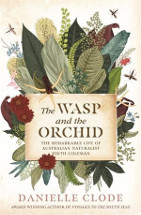The wasp and the orchid by Danielle Clode

Picador:Pan MacMillan, 2018. ISBN 9781760554286
(Age: Adult) Themes: Environment. Orchids. Women in science. Edith Coleman.
Botany. This is an insightful biography of Edith Coleman, a woman who
demonstrated the observation skills of a keen scientist and
naturalist and was able to make a difference in the scientific
world, without being a professional or academic. Her
observations revolutionised understanding in the biological world in
the early 20th Century, and yet she was not a scientist, just a
dedicated observer and recorder and communicator of these findings.
In the era when Edith Coleman lived, women were often deemed to be a
'lesser light', and expert only in domestic issues. Edith Coleman
demonstrated that with careful records and clear communication that
it was possible for women to make a significant contribution to the
world of natural science (even as an amateur). Her great claim to
fame was to describe the link between a wasp and the fertilisation
of a look-alike orchid, in a process known as pseudo-copulation.
Danielle Clode has revealed an impressive and detailed unveiling of
all that Edith Coleman was - child, sibling, wife, mother, keen
nature observer, contributor to academic understanding, and a
refreshing writer. Coleman's humanity shines through the enjoyable
discourse of the researcher Clode, who writes her own refreshing
insights on the process of finding snippets of biographical detail
in a myriad of hidden locations - from herbarium records to Field
Naturalist journals and personal communications. This record is both
an in-depth investigation and a lyrical and reflective personal
journey that is full of beautiful language and images of gardens and
natural wonderlands sprinkled with orchids. In reading this book we
remember Edith Coleman, an unsung luminary in Australian biology,
and although this may not appeal to all readers, it will be loved by
any reader who is interested in the way that ordinary people with a
passion for the environment can make a difference. The historical
view of life at the turn of the 20th Century is also delightful, and
Edith Coleman's daughters are revealed as equally influential in the
recording of natural science. Clode's writing reveals her own
joy in communicating science in a way that would appeal to a
non-scientific audience.
Highly recommended, for Adult nature lovers.
Carolyn Hull